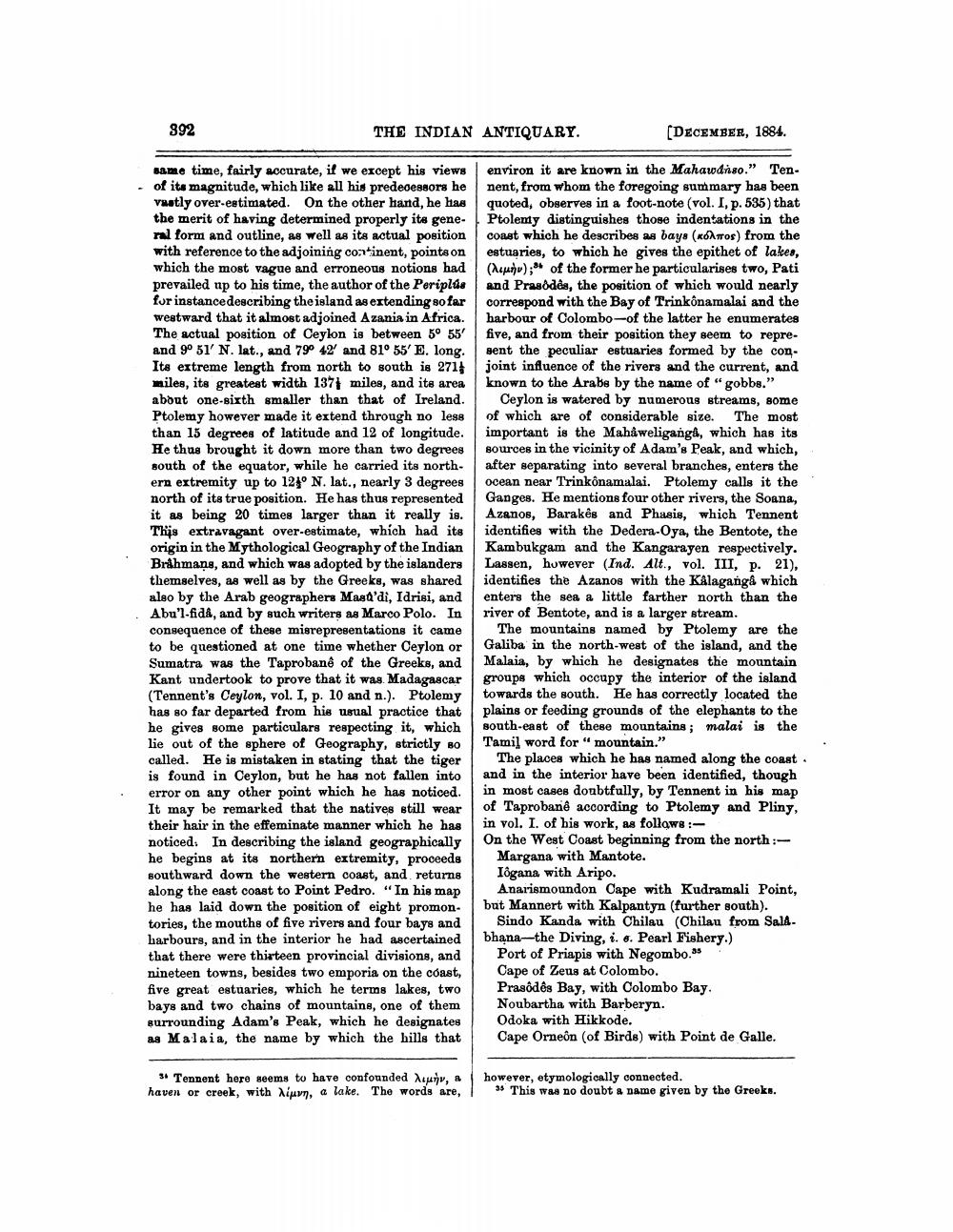________________
992
THE INDIAN ANTIQUARY.
(DECEMBER, 1884.
same time, fairly accurate, if we except his views of its magnitude, which like all his predecessors he vaatly over-estimated. On the other hand, he has the merit of having determined properly ite generul form and outline, as well as its actual position with reference to the adjoining continent, points on which the most vague and erroneous notions had prevailed up to his time, the author of the Periplús for instance describing the island as extending so far westward that it almost adjoined Azania in Africa. The actual position of Ceylon is between 5° 55' and 9° 51' N. lat., and 79° 42' and 81° 55' E. long. Its extreme length from north to south is 2711 miles, its greatest width 1371 miles, and its area about one-sixth smaller than that of Ireland. Ptolemy however made it extend through no less than 15 degrees of latitude and 12 of longitude. He thus brought it down more than two degrees south of the equator, while he carried its northern extremity up to 121° N. lat., nearly 3 degrees north of its true position. He has thus represented it as being 20 times larger than it really is. This extravagant over-estimate, which had its origin in the Mythological Geography of the Indian Brahmans, and which was adopted by the islanders themselves, as well as by the Greeks, was shared also by the Arab geographers Maad'di, Idrisi, and Abu'l-fidâ, and by such writers as Marco Polo. In consequence of these misrepresentations it came to be questioned at one time whether Ceylon or Sumatra was the Taprobanê of the Greeks, and Kant undertook to prove that it was Madagascar (Tennent's Ceylon, vol. I, p. 10 and n.). Ptolemy has so far departed from his usual practice that he gives some particulars respecting it, which lie out of the sphere of Geography, strictly Bo called. He is mistaken in stating that the tiger is found in Ceylon, but he has not fallen into error on any other point which he has noticed. It may be remarked that the natives still wear their hair in the effeminate manner which he has noticed. In describing the island geographically he begins at its northern extremity, proceeds southward down the western coast, and returns along the east coast to Point Pedro. "In his map he has laid down the position of eight promon tories, the mouths of five rivers and four bays and barbours, and in the interior he had ascertained that there were thirteen provincial divisions, and nineteen towns, besides two emporia on the coast, five great estuaries, which he terms lakes, two bays and two chains of mountains, one of them surrounding Adam's Peak, which he designates as Malaia, the name by which the hills that
environ it are known in the Mahawdnso." Tennent, from whom the foregoing summary has been quoted, observes in a foot-note (vol. I, p. 535) that Ptolemy distinguishes those indentations in the coast which he describes as bays (KoAmos) from the estuaries, to which he gives the epithet of lakes, (Acunu);" of the former he particularises two, Pati and Prasodes, the position of which would nearly correspond with the Bay of Trinkónamalai and the harbour of Colombo-of the latter he enumerates five, and from their position they seem to represent the peculiar estuaries formed by the con. joint influence of the rivers and the current, and known to the Arabs by the name of "gobba."
Ceylon is watered by numerous streams, some of which are of considerable size. The most important is the Mahåweliganga, which has its sources in the vicinity of Adam's Peak, and which, after separating into several branches, enters the ocean near TrinkÔnamalai. Ptolemy calls it the Ganges. He mentions four other rivers, the Soana, Azanos, Barakes and Phasis, which Tennent identifies with the Dedera-Oya, the Bentote, the Kambukgam and the Kangarayen respectively. Lassen, huwever (Ind. Alt., vol. III, p. 21), identifies the Azanos with the Kalaganga which enters the sea a little farther north than the river of Bentote, and is a larger stream
The mountains named by Ptolemy are the Galiba in the north-west of the island, and the Malaia, by which he designates the mountain groups which occupy the interior of the island towards the south. He has correctly located the plains or feeding grounds of the elephants to the south-east of these mountains; malai is the Tamil word for "mountain."
The places which he has named along the coast. and in the interior have been identified, though in most cases doubtfully, by Tennent in his map of Taprobanê according to Ptolemy and Pliny, in vol. I. of his work, as follows:On the West Coast beginning from the north :
Margana with Mantote. Iogana with Aripo.
Anarismoundon Cape with Kudramali Point, but Mannert with Kalpantyn (further south).
Sindo Kanda with Chilau (Chilau from Sall. bhana--the Diving, i. 8. Pearl Fishery.)
Port of Priapis with Negombo. Cape of Zeus at Colombo. Prasôdês Bay, with Colombo Bay. Noubartha with Barberyn. Odoka with Hikkode. Cape Omen (of Birds) with Point de Galle.
31 Tennent here seems to have confounded Aauny, a haven or creek, with Niurn, a lake. The words are,
however, etymologically connected.
" This was no doubt a name given by the Greeks.




